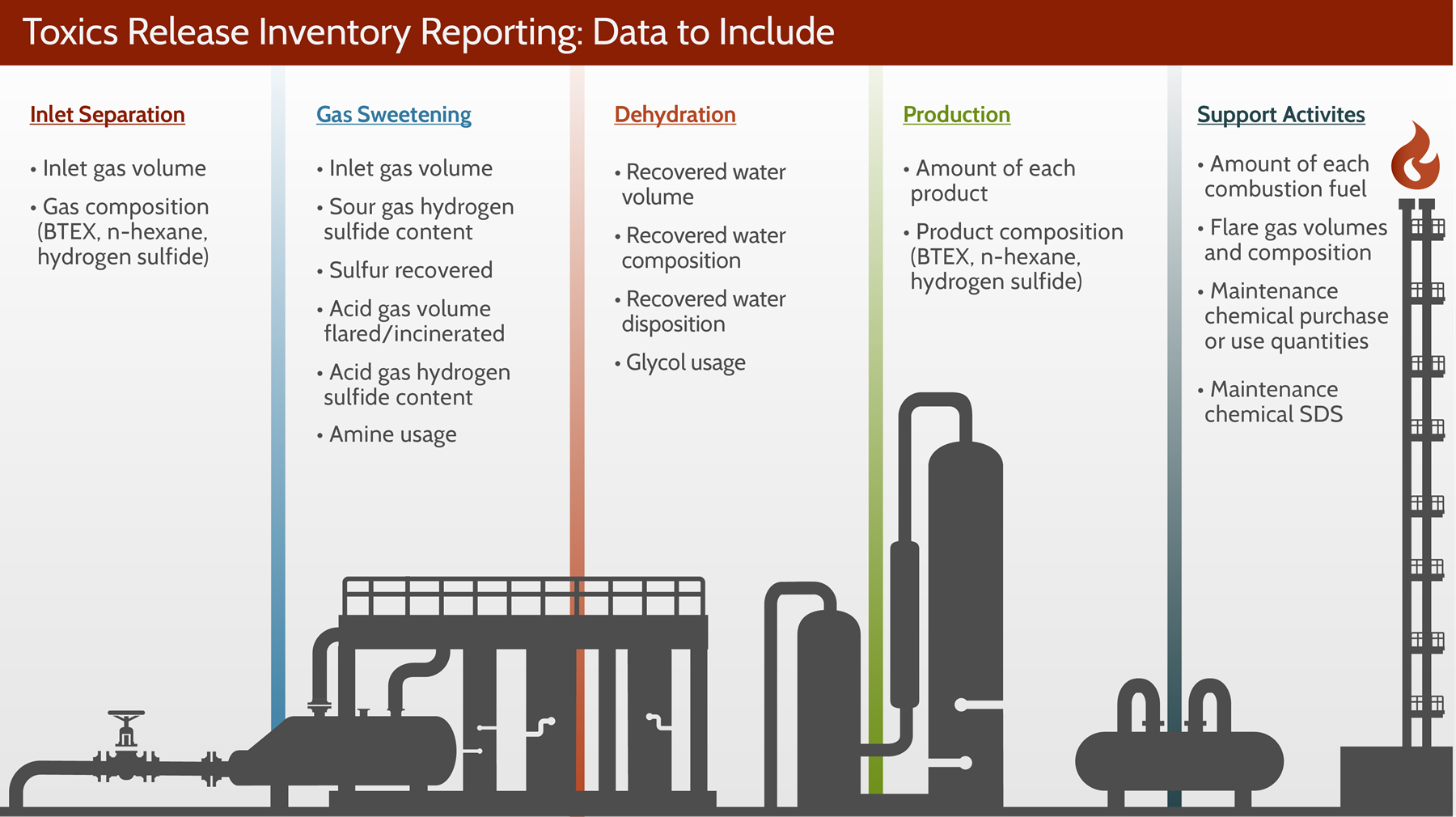In November 2021, the Environmental Protection Agency (EPA) expanded the list of industrial sectors covered by the Toxics Release Inventory (TRI) to include all facilities that process natural gas. EPA estimates at least 321 natural gas processing facilities will be subject to TRI beginning in 2023 and will be required to submit TRI data for calendar year 2022. If not already doing so, natural gas processing facilities are advised to assess whether TRI applies to them and take steps to confirm necessary data is being collected and organized appropriately.
Tell me more about TRI
TRI was enacted in 1986 under the Emergency Planning and Community Right-to-Know Act (EPCRA), Section 313. Under TRI, U.S. facilities in certain industry sectors and with more than 10 full-time employees must evaluate quantities of listed chemicals manufactured, processed, and otherwise used and compare those quantities to the applicable reporting threshold for each chemical to determine if report submittal is required.
An annual threshold evaluation must be performed for each TRI-listed chemical. While most TRI-listed chemicals do not require reporting unless a facility's activity quantity exceeds 10,000 pounds for otherwise use or 25,000 pounds for manufactured or processed, certain persistent bioaccumulative toxic (PBT) chemicals (e.g., per and polyfluoroalkyl substances [PFAS], lead, and dioxins) have much lower reporting thresholds.
Facilities that exceed the reporting threshold are required to report information on the quantities released to the environment and/or managed through recycling, energy recovery, and treatment. This information is reported annually by July 1 for the prior calendar year. EPCRA Section 313 and reporting guidance do not specify the types of data facilities should collect to perform the threshold evaluation or to calculate releases and management quantities. Facilities should use the best available information and document the data sources used in threshold evaluation and release/management calculations.
Facilities that do not exceed the reporting threshold should maintain adequate documentation demonstrating the rationale for not reporting (e.g., negative declaration) in the event of an audit or agency inquiry.
As in any compliance endeavor, collecting and reporting defensible data for TRI reporting is vital. Notably, data reported under TRI is completely public. Once EPA releases TRI data to the public, it can be used by various groups and individuals to assess quantities of TRI-reportable chemicals released into the air and water in communities around industrial areas in support of environmental justice efforts.
Is TRI reporting complex?
The complexity of TRI reporting can be a function of the extent and format by which a facility collects material usage data, emissions data, and waste disposal data. Facilities new to managing TRI reporting will want to capitalize on “getting it right” the first time around. If the processes surrounding TRI reporting are thoughtfully established, then subsequent years’ reports are likely to be a streamlined experience consisting of primarily updating the variable inputs.
Once TRI data is compiled, reporting is done via electronic submittal using EPA’s TRI-MEweb in the CDX portal. Reporting consists of two types of forms:
- Form A – Simple (2 pages per chemical)
- Threshold <1,000,000 pounds, annual reportable amount <500 pounds
- Does not apply to PBT chemicals
- Form R – More complex (7 pages per chemical)
- Does not meet Form A criteria
EPA has strong enforcement authority under the long-standing rule. If a company subject to TRI does not report, EPA may assert that the company must provide a negative applicability and can issue considerable fines for non-compliance.
How do I determine if TRI applies to my facility?
TRI applicability is assessed using a combination of NAICS codes and labor hours as well as a determination of whether or not a site manufactures, processes, or otherwise uses TRI-reportable materials. For natural gas processing facilities, most sites will have to evaluate several TRI-reportable chemicals against the activity thresholds and submit a report for at least one TRI-reportable chemical.
- How to evaluate thresholds:
- Determine if the facility has more than 10 full-time employees and operates under one of the newly listed NAICS codes.
- Evaluate the amount of each TRI-reportable chemical processed through the facility using inlet gas volume and detailed compositional data (e.g., BTEX, n-hexane, and hydrogen sulfide) for comparison with the 25,000-pound threshold.
- Evaluate the amount of each TRI-reportable chemical manufactured using production volumes, compositional data, and combustion fuel usage for comparison with the 25,000-pound threshold. Note that intermediate compounds could be considered as “manufactured” even if a subsequent process consumes that chemical.
- Evaluate the amount of each TRI-reportable chemical otherwise used for gas sweetening, dehydration, water treatment, and maintenance for comparison with the 10,000-pound reporting threshold.
- Compare the manufactured, processed, and otherwise used quantities for Persistent Bioaccumulative Toxic (PBT) chemicals against the lower reporting thresholds.
- How to calculate releases: A facility could use existing regulatory reports to determine the amount of each TRI-reportable chemical released into the air, water, and waste. Existing regulatory reports can include air emission inventories, 40 CFR Part 98 greenhouse gas mandatory reports, surface water and wastewater discharge monitoring reports, and hazardous waste biennial reports. Facilities that are not required to submit certain regulatory reports can use internal recordkeeping and engineering calculations to estimate releases. Facilities should note that consistency is key. A common pitfall leading to agency inquiries and audits can be reporting different quantities for air or water releases on regulatory submittals and TRI reports.
When is the next TRI report due?
The next TRI report is due July 1, 2023, for calendar year 2022 data. Note that the regulations do not include any provisions for requesting an extension on the due date and a failure to report on the due date is considered a violation.
Learn more about the types of data to include

Questions?
If you have TRI-related questions or would like assistance in understanding if your facility meets TRI reporting threshold requirements, connect with us using the form linked below.
